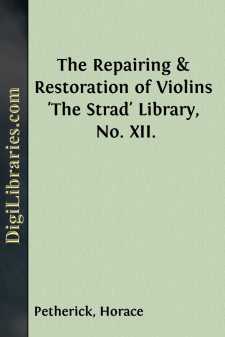Categories
- Antiques & Collectibles 13
- Architecture 36
- Art 48
- Bibles 22
- Biography & Autobiography 813
- Body, Mind & Spirit 142
- Business & Economics 28
- Children's Books 14
- Children's Fiction 11
- Computers 4
- Cooking 94
- Crafts & Hobbies 4
- Drama 346
- Education 46
- Family & Relationships 57
- Fiction 11829
- Games 19
- Gardening 17
- Health & Fitness 34
- History 1377
- House & Home 1
- Humor 147
- Juvenile Fiction 1873
- Juvenile Nonfiction 202
- Language Arts & Disciplines 88
- Law 16
- Literary Collections 686
- Literary Criticism 179
- Mathematics 13
- Medical 41
- Music 40
- Nature 179
- Non-Classifiable 1768
- Performing Arts 7
- Periodicals 1453
- Philosophy 64
- Photography 2
- Poetry 896
- Political Science 203
- Psychology 42
- Reference 154
- Religion 513
- Science 126
- Self-Help 84
- Social Science 81
- Sports & Recreation 34
- Study Aids 3
- Technology & Engineering 59
- Transportation 23
- Travel 463
- True Crime 29
The Repairing & Restoration of Violins 'The Strad' Library, No. XII.
by: Horace Petherick
Categories:
Description:
Excerpt
CHAPTER I.
I.The art of the old liutaro of Italy may be said to have become during the last two or three centuries, identified with the art of constructing such musical instruments as are played with the bow.
As was the case with other and kindred arts, that of violin making had its rise in one of the old cities of Italy, where from small beginnings it gradually spread to other places and over the borders, until there are very few places of importance where it was not practised with some degree of success, commercially if not artistically and acoustically considered.
During the early period of the art, repairing was of a rough and ready kind, chiefly in connection with damages sustained under ordinary usage and accident; while extensive and costly renovating, such as is so frequently undertaken at the present day, must have been of rare occurrence, for the reason that it was then quite possible to get equal, sometimes better, quality in quite new instruments which were being sent forth every day by the resident makers. With the onward march of time this has been changed; the art of the Italian liutaro having reached its climax some century and a half back, the masterpieces executed during that time are gradually diminishing in number and cannot be replaced by instruments having a sufficiently high degree of excellence; naturally enough the skill of the repairer has been more and more in requisition, so much so, that many who have shown exceptional ability for this kind of work have achieved a reputation for it alone, among the large circle of dealers in the principal cities of Europe. The necessities of the time have thus brought into prominence a modification of the art of the old Italian liutaro, in which there has to be displayed much more mechanical ingenuity if with very little or no originality; the high class of artisan has become strongly in evidence, while the artist has disappeared. It was in the consideration of these facts that the idea was first suggested that a work treating of the general methods adopted by professional restorers for important work, coupled with helpful hints in the management of minor injuries, would be interesting and acceptable to amateur as well as professional repairers, besides the numerous readers of T S, in the pages of which the following chapters were first issued.
In sending out the matter in book form, some alterations and additions have been, as usual, found advisable for completeness. All readers readily admit the impossibility of touching upon one half of the various accidents and ailments to which a violin is liable during its usually long life; the most likely ones have therefore been taken, and it is hoped that the suggested treatment of these cases may enable the repairer to become sufficiently adept for undertaking such others, serious, or slight, as may not have been here referred to.
Further, the author is hopeful that those readers who may feel indisposed themselves to put into practice the various hints, instruction, or advice, will be enabled by knowing how good repairing is carried out, to select the proper kind of person into whose hands they can safely intrust their cherished instruments.
...


